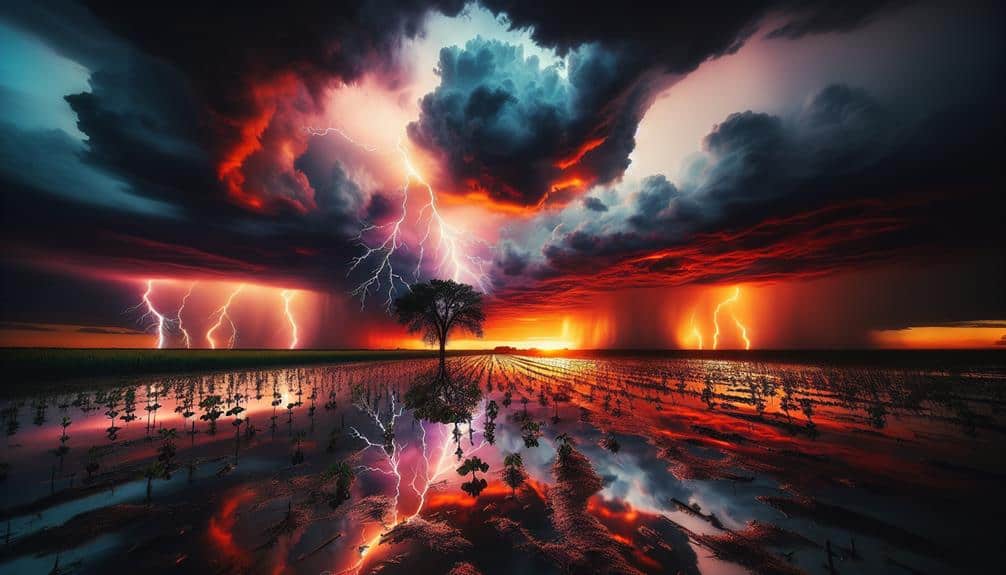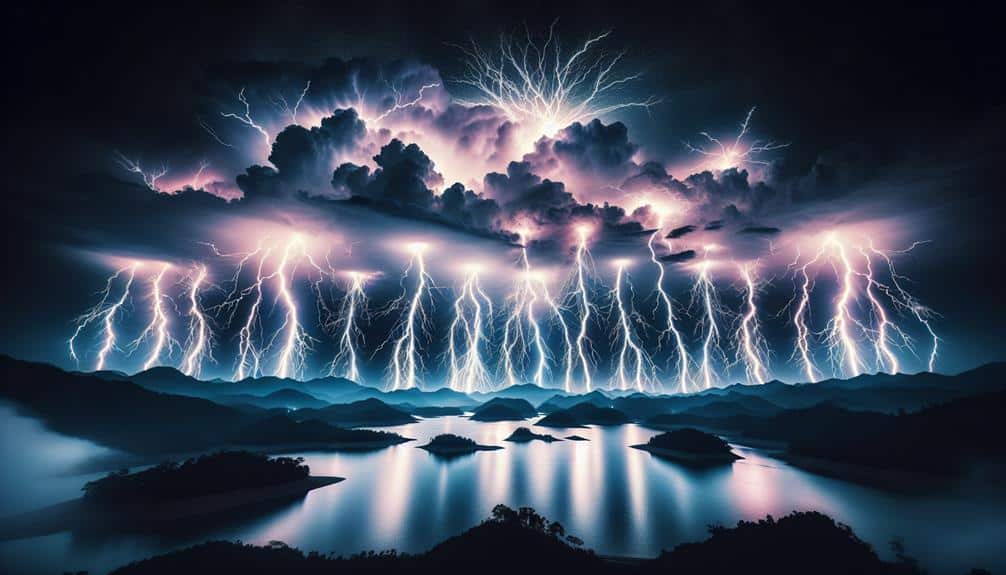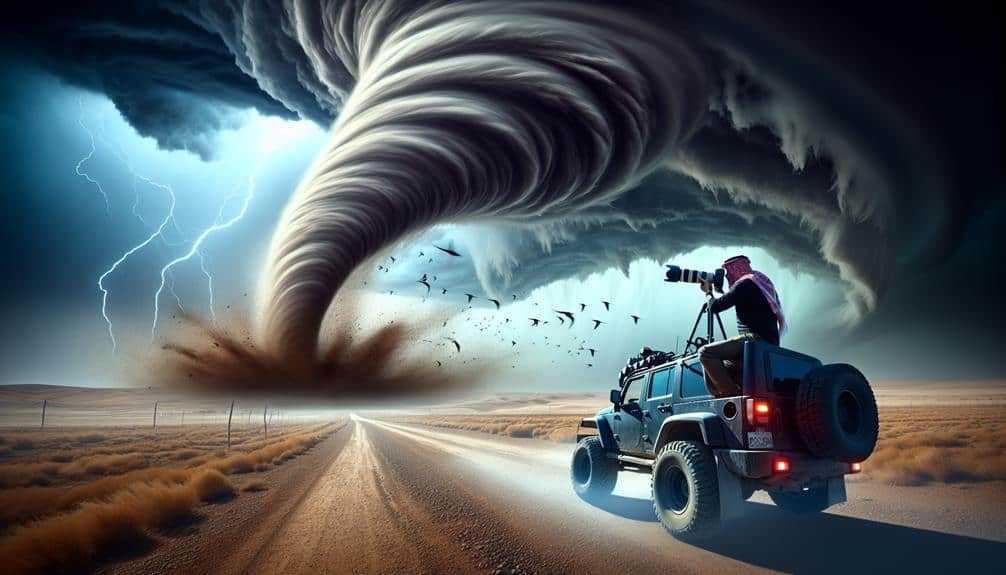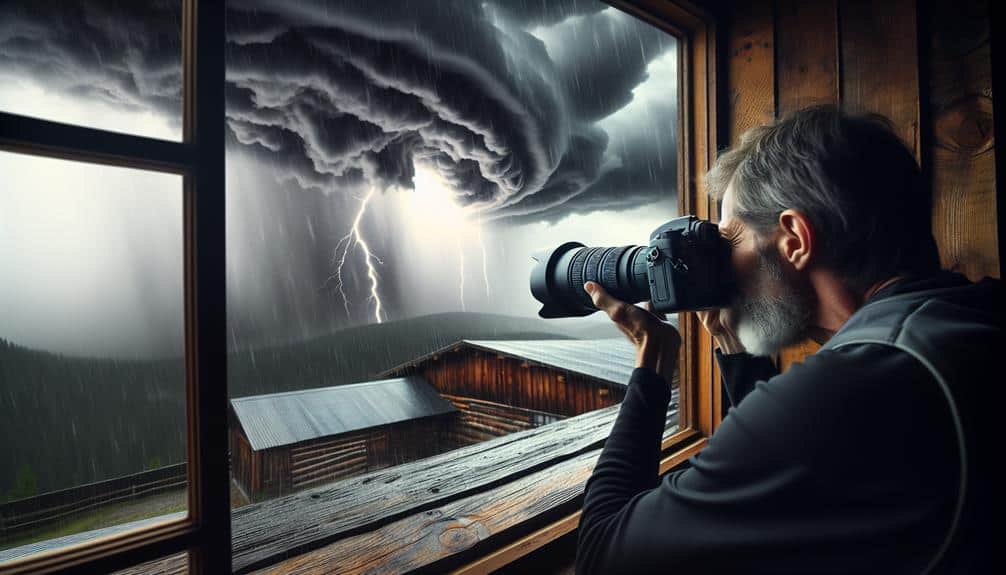Photographing dramatic sunsets during thunderstorms calls for our technical expertise and artistic vision, combined with careful preparation. We need gear like adjustable lighting, sturdy tripods, and high-speed memory cards. Mastering weather forecasts and selecting open vistas with engaging foregrounds is essential. Capture dynamic interplay by using a lower ISO and slower shutter speed, and enhance dramatic effects with filters. For impactful compositions, experiment with angles and utilize silhouettes. Adjust color balance and vibrance thoughtfully to avoid oversaturation. Prioritize safety by avoiding lightning-prone areas. Dive deeper into these techniques to transform stormy sunsets into mesmerizing visual stories.
Key Points
- Use sturdy tripods to keep your camera stable during windy conditions.
- Monitor weather forecasts closely to capture dramatic clouds and lighting.
- Utilize lower ISO settings and slower shutter speeds to enhance cloud movement and color richness.
- Incorporate silhouettes and unique lighting techniques to add depth and storytelling to your photos.
Essential Gear Checklist
When preparing to capture the breathtaking interplay of light and storm, we must make certain our gear checklist is complete and meticulously curated.
First, our lighting equipment is essential; even though natural light plays a significant role, portable lights can help highlight foreground elements. Confirm these lights are durable and have adjustable settings.
Protection gear is non-negotiable. We need sturdy tripods to stabilize our cameras against the wind. Lens hoods and filters shield lenses from rain and dust. Don't forget a reliable rain cover for the camera body.
Backup batteries are lifesavers. Thunderstorms can last longer than expected, and there's nothing worse than a dead battery just as the sky erupts in a blaze of color. Always carry multiple fully charged batteries in a waterproof casing to prevent moisture damage.
We can't overlook memory cards. High-capacity, high-speed cards guarantee we don't miss any fleeting moment or struggle with buffer issues during rapid shooting.
Choosing the Right Location
Choosing the right location to photograph dramatic sunsets in thunderstorms requires a blend of technical expertise and artistic vision, ensuring we position ourselves where the landscape and weather conditions will create the most striking compositions.
First, we need to master weather forecasting. Monitoring storm patterns and sunset times is pivotal. Tools like radar apps, weather websites, and storm-chasing forums will help us predict the perfect convergence of a thunderstorm and a sunset.
Next, landscape scouting is essential. We should explore locations that offer open vistas and interesting foreground elements like lakes, mountains, or lone trees. These elements can add depth and scale to our photos. It's important to avoid areas with too many obstructions like buildings or dense forests, as they can block our view and diminish the dramatic effect of the stormy sunset.
We should also consider elevation. High ground, such as hills or elevated platforms, often provides a better vantage point to capture the expansive sky and storm clouds. Let's always prioritize our safety by choosing spots that aren't prone to lightning strikes or flash floods.
Timing Your Shots
Capturing the perfect moment in stormy sunsets demands precise timing to seize the interplay of light and clouds at their most pivotal. We need to keenly observe the weather conditions, as thunderstorms can rapidly evolve. Monitoring weather forecasts helps us identify when a storm will coincide with sunset.
The golden hour, just before the sun dips below the horizon, often offers the most breathtaking lighting conditions, casting warm hues that contrast with ominous storm clouds.
Positioning ourselves strategically is essential. By choosing a vantage point with a clear view of both the horizon and the approaching storm, we can frame our shots to capture the full spectrum of colors and textures. Adjusting our angles allows us to exploit the dynamic interplay between sunlight and storm clouds.
Shooting from a low angle can emphasize the towering clouds, while a higher vantage point might highlight the expansive landscape bathed in dramatic light.
Timing our shots also involves patience. As the storm progresses, the light will change rapidly, offering brief moments of perfect illumination. By staying alert and ready, we can capture those fleeting instants where the lighting conditions and weather conditions align to create stunning, memorable images.
Camera Settings for Dramatic Effects
To achieve dramatic effects in our sunset storm photography, we must meticulously adjust our camera settings to balance exposure, contrast, and saturation.
First, we need to dial in our exposure adjustments. By using a lower ISO setting, typically around 100-200, we can reduce noise and capture the rich colors of the sunset and storm clouds. Additionally, consider using a slower shutter speed to emphasize movement in the clouds, but be cautious of overexposure.
Next, let's explore creative filters. A graduated neutral density (ND) filter can help manage the bright horizon while keeping the stormy sky dark and brooding. Polarizing filters are also excellent for enhancing the vibrancy of colors and reducing glare, giving us more control over the final image.
For contrast enhancement, increasing the contrast setting in-camera or in post-processing can help make the storm clouds stand out against the vivid sunset. White balance tweaks are essential too; setting it to ‘cloudy' or manually adjusting the Kelvin temperature can warm up the scene, bringing out the golden hues of the sunset.
Composition Tips for Impactful Photos

With our camera settings finely tuned, we need to focus on crafting compelling compositions that highlight the dramatic interplay between the stormy sky and the vibrant sunset. The first step is to understand how the unique lighting techniques and weather conditions can enhance our photos. By positioning ourselves where the light breaks through the clouds, we can capture striking contrasts between the illuminated sky and dark storm clouds.
Next, let's talk about creative angles. Shooting from a low angle can emphasize the grandeur of the storm clouds, making the sky appear even more imposing. Conversely, a high angle can offer a sweeping view of the landscape, showing the storm's vastness against the glowing horizon. We should experiment with various perspectives to find the most impactful shot.
Incorporating elements like silhouetted trees or buildings can add a layer of visual storytelling to our photos. These elements can serve as focal points, guiding the viewer's eye through the image and creating a narrative that speaks to the power and beauty of nature.
Safety Precautions
Ensuring our safety while photographing thunderstorms is paramount, as the volatile weather conditions pose significant risks. First, let's address lightning safety. Lightning is unpredictable and can strike from miles away. We should never stand under isolated trees or open fields—both are lightning magnets. Instead, the safest option is to photograph from inside a vehicle with the windows up. It acts as a Faraday cage, offering protection.
Storm shelters are another essential consideration. Familiarize ourselves with nearby storm shelters or sturdy buildings before heading out. If we're in a remote area, identify low-lying terrains that can serve as temporary shelters. Always keep a weather app handy to receive real-time updates and alerts.
When setting up our camera gear, prioritize waterproof equipment or use rain covers to protect our gear. Avoid using tripods in open areas during active lightning, as metal can conduct electricity. Also, keep our movements flexible and be ready to pack up quickly if conditions worsen.
Post-Processing Techniques

Now that we've captured our dramatic sunset amidst a thunderstorm, let's focus on enhancing color vibrancy and reducing noise artifacts in post-processing.
We'll start by boosting saturation and adjusting color curves to bring out the vivid hues.
Next, use noise reduction tools to clean up any graininess, ensuring our image retains its sharpness and clarity.
Enhancing Color Vibrancy
To enhance the color vibrancy of your sunset photographs, we should start by adjusting the white balance to bring out the warm hues. By shifting the white balance towards the warmer end of the spectrum, we can emphasize the reds, oranges, and yellows that make sunset images so alluring. This adjustment sets the stage for the rest of our enhancements.
Next, we'll fine-tune the color balance. Open your photo editing software and navigate to the color balance settings. Here, we can adjust the midtones, highlights, and shadows individually. For sunsets, we typically want more warmth in the highlights and midtones while keeping the shadows cooler to maintain contrast.
Let's not forget about filter options. Using graduated filters can help us enhance the sky without affecting the foreground. Apply a warm filter to the upper part of the image, gradually blending it into the cooler tones below. This technique adds depth and drama.
We should also consider using vibrance and saturation sliders, but with caution. Increase vibrance to boost muted colors without oversaturating the already vibrant parts of the image. This keeps our colors rich and lively while maintaining a natural look.
Reducing Noise Artifacts
Reducing noise artifacts in our sunset photographs requires a combination of precise adjustments and the right software tools to maintain image quality and detail. When capturing dramatic sunsets amid thunderstorms, long exposure and tripod stability are essential. However, even with perfect shooting techniques, noise can still creep into our images, especially in low-light conditions.
Here's how we can effectively tackle this issue:
- Noise Reduction Software: Utilize advanced editing software like Adobe Lightroom or DxO PhotoLab. These programs offer sophisticated noise reduction algorithms that can significantly reduce grain while preserving essential details.
- Manual Adjustments: Fine-tuning the luminance and color noise sliders can make a significant difference. Start with small increments and gradually adjust until the noise is reduced without sacrificing sharpness.
- Stacking Images: For those who want to go a step further, stacking multiple exposures can help. This technique involves combining several shots to average out noise, resulting in a cleaner, more detailed image.
Frequently Asked Questions
How Can I Predict a Thunderstorm for Better Sunset Photography?
To predict a thunderstorm for better sunset photography, we analyze weather patterns and sunset timing. By tracking storm clouds in weather apps, we can plan our photography techniques to capture dramatic skies and vibrant colors.
What Are the Best Apps for Weather Forecasting Before a Sunset Shoot?
Just as Van Gogh sought perfect light, we rely on weather apps like Dark Sky, AccuWeather, and WeatherBug for sunset photography. Their accuracy predictions help us capture ideal lighting conditions for stunning, dramatic shots.
How Do I Protect My Camera Gear From Sudden Rain During a Shoot?
To protect our gear from sudden rain, we use rain cover solutions and water-resistant equipment. We also seek emergency shelter or store gear in protective cases, ensuring our artistic vision isn't compromised by unexpected weather changes.
What Are the Ideal Lenses for Capturing Wide-Angle Shots of Sunsets and Storms?
Capturing the sky's canvas requires the right tools. We recommend using a 16-35mm lens for expansive shots. For compelling composition, let storm clouds frame the sunset, creating a dramatic juxtaposition. Embrace your artistic vision and freedom.
How Can I Ensure the Stability of My Tripod in Windy Conditions?
To guarantee tripod stability in windy conditions during sunset photography and thunderstorms, we can use weight hooks, stabilize with ground spikes, and lower the tripod height. These measures help maintain sharp, dramatic shots amid nature's chaos.


